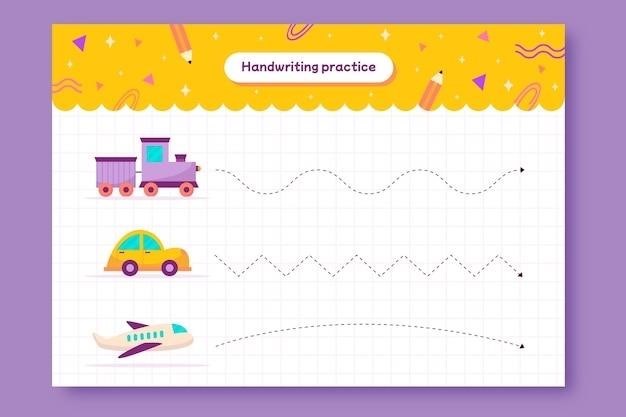Understanding Slope of a Line
This section explores the fundamental concept of slope, its calculation methods, and its significance in understanding the steepness and direction of a line․ Worksheets utilizing these methods are readily available online in PDF format, offering practice problems for various skill levels․ These resources often include visual aids and step-by-step solutions․
Defining Slope
The slope of a line, often denoted by ‘m’, quantifies its steepness and direction․ It represents the ratio of the vertical change (rise) to the horizontal change (run) between any two distinct points on the line․ A positive slope indicates an upward trend from left to right, while a negative slope shows a downward trend․ A slope of zero signifies a horizontal line, meaning no vertical change, and an undefined slope corresponds to a vertical line, implying an infinite vertical change with no horizontal change․ Understanding slope is crucial for analyzing linear relationships and solving various mathematical problems․ Many online resources, including slope of a line worksheet PDFs, provide detailed explanations and practice exercises to solidify this fundamental concept․ These worksheets often include graphs and tables to aid in visualizing and calculating slope․ Mastering slope calculation is essential for further studies in algebra and related fields․
Calculating Slope from Two Points
Given two points (x₁, y₁) and (x₂, y₂), the slope ‘m’ of the line passing through them is calculated using the formula⁚ m = (y₂ — y₁) / (x₂ — x₁)․ This formula represents the rise (vertical change, y₂, y₁) divided by the run (horizontal change, x₂ ⎼ x₁)․ Numerous online resources, including readily available slope of a line worksheet PDFs, provide ample practice in applying this formula․ These worksheets often present pairs of coordinates, requiring students to substitute the values into the formula and compute the slope․ Some worksheets might also include graphical representations, allowing students to visually verify their calculated slopes․ It’s crucial to remember that the order of points doesn’t affect the absolute value of the slope, but it does influence the sign, correctly reflecting the line’s direction (increasing or decreasing)․ Accuracy in calculating slope is fundamental to solving numerous problems in algebra and related mathematical disciplines․ Mastering this skill is essential for further mathematical progress․
Calculating Slope from a Graph
Determining the slope of a line directly from its graph offers a visual approach to understanding this concept․ Many slope of a line worksheet PDFs incorporate this method, presenting students with various line graphs․ To calculate the slope, select two distinct points on the line that are easily identifiable on the grid․ Count the vertical distance (rise) between these points and the horizontal distance (run)․ The slope is then the rise divided by the run․ For instance, if the rise is 3 units and the run is 2 units, the slope is 3/2 or 1․5․ Positive slopes indicate lines that ascend from left to right, while negative slopes represent lines descending from left to right․ Horizontal lines have a slope of zero, and vertical lines have an undefined slope․ Practice worksheets often include graphs with varying slopes, encouraging students to develop their visual interpretation skills and reinforce their understanding of slope calculation․ The ability to quickly determine slope from a graph is a valuable skill in many mathematical contexts․

Types of Slopes
This section categorizes slopes into four types⁚ positive, negative, zero, and undefined․ Many online slope of a line worksheet PDFs include exercises identifying these types based on graphical representations or calculated values․ Understanding these categories is crucial for interpreting line characteristics․
Positive Slope
A positive slope indicates a line that rises from left to right․ This means that as the x-values increase, the corresponding y-values also increase․ The slope’s value is a positive number, representing the ratio of the vertical change (rise) to the horizontal change (run)․ Numerous online slope worksheets feature graphs of lines with positive slopes, requiring students to calculate the slope using the coordinates of two points on the line or to identify the type of slope from a visual representation․ These exercises reinforce the understanding of the relationship between the line’s direction and the sign of its slope․ Practice problems often involve finding the slope from a graph, a table of values, or two given points․ Mastering positive slope calculations is fundamental to understanding linear relationships and interpreting real-world applications, such as determining the rate of change in various scenarios․ Students will encounter various levels of difficulty in these worksheets, ensuring a comprehensive understanding of positive slopes․
Negative Slope
A negative slope signifies a line that descends from left to right․ This means that as the x-values increase, the y-values decrease proportionally․ The slope’s numerical value is negative, representing the ratio of the vertical change (rise, which is negative in this case) to the horizontal change (run)․ Many online slope worksheets include exercises where students identify lines with negative slopes from graphs or calculate the slope using the coordinates of two points on a downward-sloping line․ These exercises often require students to interpret the negative slope in the context of real-world problems, such as analyzing decreasing trends in data or understanding the relationship between variables where one decreases as the other increases․ The worksheets provide opportunities to practice calculating the slope using the formula and interpreting the negative sign correctly․ Understanding negative slopes is crucial for comprehending linear relationships and analyzing various real-world phenomena that exhibit a negative correlation between variables․
Zero Slope
A line with a zero slope is a horizontal line․ This means there is no change in the y-values as the x-values change․ The slope is calculated as the change in y divided by the change in x; in a horizontal line, the change in y is always zero, resulting in a slope of zero․ Many online slope worksheets present problems involving identifying horizontal lines and calculating their slopes from graphs or coordinate pairs․ These worksheets may include practice problems that require students to distinguish between zero slope and undefined slope, emphasizing the difference between horizontal and vertical lines․ Students may also be asked to write the equation of a horizontal line given a point on the line, reinforcing the understanding that the equation of a horizontal line is always of the form y = k, where k is a constant representing the y-coordinate of every point on the line․ Understanding zero slope is vital for recognizing and interpreting constant functions and situations where one variable remains unchanged while the other varies․
Undefined Slope
A vertical line possesses an undefined slope․ This arises from the formula for calculating slope⁚ the change in y divided by the change in x․ In a vertical line, the change in x is always zero, leading to division by zero, which is undefined in mathematics․ Numerous online slope worksheets incorporate exercises focusing on identifying vertical lines and understanding why their slopes are undefined․ These worksheets often feature graphical representations of lines or sets of coordinates from which students must determine the slope, reinforcing the concept of undefined slope as a characteristic of vertical lines․ Students might also be presented with scenarios requiring them to write equations of vertical lines, emphasizing that these equations are always of the form x = k, where k is a constant representing the x-coordinate of every point on the line․ Recognizing undefined slopes is crucial for comprehending the limitations of the slope concept and for correctly interpreting vertical relationships between variables․

Slope Worksheets⁚ Practice Problems
Numerous online resources offer slope worksheets in PDF format, providing various practice problems․ These range from calculating slope given two points to identifying slope types from graphs․ Answer keys are often included for self-assessment․
Worksheet 1⁚ Finding Slope from Two Points
This worksheet focuses on the fundamental skill of calculating the slope of a line when given the coordinates of two points on that line․ Students will utilize the slope formula, often expressed as “rise over run” or (y₂ ⎼ y₁) / (x₂ ⎼ x₁), to determine the slope’s numerical value․ The worksheets typically present a series of coordinate pairs, requiring students to apply the formula systematically․ Some worksheets might include a mix of positive, negative, zero, and undefined slopes to reinforce a comprehensive understanding․ This exercise reinforces the understanding of how changes in y-coordinates (rise) relate to changes in x-coordinates (run) to define the line’s inclination․ The availability of answer keys allows students to check their work and identify any misconceptions․ This targeted practice enhances problem-solving skills and reinforces a core concept in linear algebra․
Worksheet 2⁚ Finding Slope from a Graph
Worksheet 2 shifts the focus from numerical coordinates to graphical representation․ Students are presented with graphs depicting various lines, each with varying slopes․ The task involves visually identifying two points on each line and then calculating the slope using the rise-over-run method․ This approach emphasizes the visual interpretation of slope, connecting the numerical calculation with the graphical representation․ The worksheets often include lines with positive, negative, zero, and undefined slopes, providing a comprehensive range of examples․ This visual approach is crucial for developing an intuitive understanding of slope, reinforcing the connection between the steepness of a line and its numerical slope․ The inclusion of both simple and more complex graphs helps to build confidence and problem-solving abilities․ Answer keys are usually provided to facilitate self-assessment and learning․
Worksheet 3⁚ Identifying Slope Types
Worksheet 3 focuses on the qualitative aspects of slope, moving beyond mere calculation․ Students are presented with various lines, either graphically or through equations, and tasked with identifying the type of slope each represents⁚ positive, negative, zero, or undefined․ This worksheet reinforces the understanding of the relationship between the slope’s numerical value and the line’s visual characteristics․ A positive slope indicates a line rising from left to right, a negative slope shows a line falling from left to right, a zero slope represents a horizontal line, and an undefined slope corresponds to a vertical line․ This exercise helps students develop a strong intuitive grasp of slope’s directional implications․ The worksheet might include tables of values, equations of lines, or graphs, demanding a diverse range of problem-solving approaches․ Answer keys are typically included to allow for self-checking and immediate feedback․
Worksheet 4⁚ Applying Slope to Real-World Problems
Worksheet 4 bridges the gap between abstract mathematical concepts and practical applications․ Students encounter real-world scenarios where understanding slope is crucial for problem-solving․ Examples might include calculating the steepness of a ramp for accessibility compliance, determining the rate of change in a quantity over time (e․g․, speed, growth), or analyzing the incline of a road for engineering purposes․ These problems require students to not only calculate slope but also interpret its meaning within the given context․ The worksheet might involve extracting relevant data from word problems, setting up equations, and providing solutions with appropriate units․ This practical application reinforces the relevance of slope and helps students connect mathematical concepts to everyday situations․ By solving these real-world problems, students gain a deeper and more meaningful understanding of slope’s practical significance․